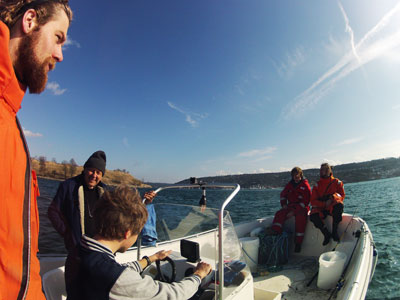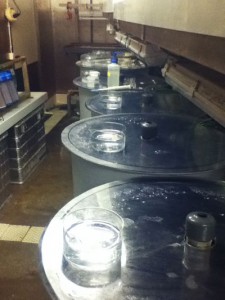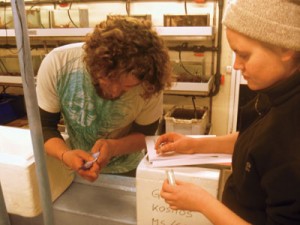After weeks of trying ourselves and with every fisherman around, we still couldn’t get any spawning fish from the Gullmar Fjord. But nevertheless, we have now cod and herring larvae in the lab and soon herring larvae in the mesocosms. The cod are from a fishing trip in the Øresund and hatched in the lab three weeks ago.
Since then we have been taking very good care of our babies, feeding them and checking on them daily.
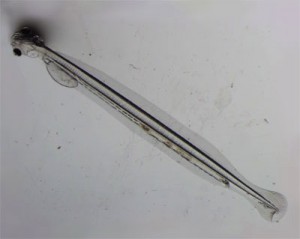
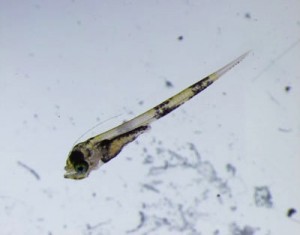
3 week old cod (bottom) and 3 day old herring (top)
So far, they have been living in 12 tanks, under four treatments of ambient and high temperature and ambient and high CO2 in all combinations and each in triplicates to check for synergistic effects of temperature and CO2 predicted for the year 2100. On April 22nd we also drove up to the Oslofjord and were lucky to get some mature herring ready to spawn.
We were able to fertilize their eggs by strip spawning them in the lab and started incubating them in the lab as well as the mesocosms. Conveniently, they have sticky eggs, which are usually attached to substrate, not free floating like the cod eggs. We could therefore stick them to plastic plates and hang them in the tanks and egg incubators in the mesocosms. The incubators are basically large plastic bottles with holes in the sides that are covered with fine mesh so the water can flow in and out. The herring will hatch in these incubators and can then swim around in there until most of them have hatched. We will then ensure that we have roughly equal numbers in every mesocosms and estimate how many there are. After that they will be transferred into the mesocosms.
In the lab they hatched two days ago and since we did not want to terminate the cod experiments but perform the herring experiment with the same set up, we had to move the grown cod larvae to new home tanks in our lab. The newly hatched herring is nearly as big as a 3-week-old cod, since the eggs are already bigger. We roughly counted how many larvae were introduced into each tank, which were at least 1,000. After a long day of putting up new tanks, moving the cod larvae, cleaning the old tanks and counting about 10,000 larvae, everybody has a new home now and for now appears to be quite happy.
Today we had a look in the egg incubators in the mesocosms and many eyes are already looking back. But they are still in their eggs, ready to hatch in the next days and to be introduced to their new big volume homes. The tanks in the labs contain 90 litres each, compared to the 55,000 litres in the mesocosms. Still, nearly the same numbers of larvae are introduced since there also is a lower food concentration in the mesocosms. The larvae in the lab are fed with plankton from the fjord, which we concentrate with a pump and a plankton filter with different mesh sizes.
So we are really looking forward to hatching larvae and need a lot of crossed fingers for the first ever introduction of fish larvae to the KOSMOS mesocosms.
